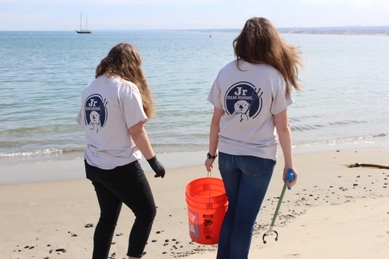|
These guys certainly had fun at last year's event, but you don't have to wait for the ICC to cleanup (Photo: NOAA).
Disappointed you missed the International Coastal Cleanup (ICC)? Or maybe you had so much fun you wish you could participate in the ICC all the time? Good news! You can host your own community cleanup anytime, no matter where you live.
Learn More
Microplastics on a beach (Photo: NOAA).
The NOAA Marine Debris Program is proud to announce our FY19 “Marine Debris Research” federal funding opportunity. This opportunity provides funding for research directly related to marine debris through field, laboratory, and modeling experiments.
Learn More
Check out the newest video in our TRASH TALK series!
When it comes to solving the problem of marine debris, most of us immediately think about solutions. We think about beach cleanups, using our own bag, and carrying a reusable water bottle. But how do we know which actions will work the best? That’s where monitoring comes in.
Check out the newest video in our TRASH TALK series following a group of high school students as they collect data on their local beach!
Learn More
Winning entry to the "Keep The Sea Free of Debris" art contest by Mia C., Grade 8, Texas.
Get your art supplies ready, because this year's NOAA Marine Debris Program Art Contest is opening soon! Students in grades K‐8 can submit artwork starting October 15th through November 30th.
Learn More
Shelby O’Neil (San Juan Bautista, CA) ran a “No Straw November” campaign to reduce the impact of single-use plastic straws on the coastal and marine environment (Photo: Bow Seat).
Congratulations to the student winners of the 2018 Bow Seat Awareness Programs' Marine Debris Creative Advocacy Competition! Students around the US took on marine debris through this challenge by using their creative skills to host art shows, upcycle materials, reach out to their local communities and officials, and more.
Learn More
Cigarette butts aren't as biodegradable as many people think. (Photo Credit: NOAA)
No butts about it – cigarettes are one of the most common types of debris found during cleanups. In 2017 alone, more than 2.4 million cigarette butts were found at cleanup sites during the International Coastal Cleanup! Why is cigarette debris such a problem, and how do we prevent it?
Learn More
Is there plastic hiding in your fall leaves? (Photo:NOAA)
It’s fall! For those of us in the temperate parts of the country, this means temperatures are getting cooler and the leaves are changing color. Those beautiful red, orange, and yellow leaves are also starting to fall, covering our yards and sidewalks, and they could also be transporting litter and debris!
Learn More
Michaela Miller and CSUCI Art Professor Matt Furmanksi hike out lobster traps and other debris from Tecolote on Santa Rosa Island (Photo: Erik Eiser).
In the Channel Islands, tackling marine debris means more than a drive to the beach! Staff and students from California State University Channel Islands and Santa Rosa Island Research Station come by boat, vehicle, and on foot to remove more than 3,000 pounds of debris from the rugged and remote shorelines of Santa Rosa and Santa Cruz Islands.
Learn More
Trash accumulated behind a trash boom in the Goat Canyon Sediment Basin after a storm in late 2016. (Photo Credit: Tijuana River NERR).
In the Tijuana River Valley, large amounts of trash, plastics, and larger debris destroy habitat, cause flooding, and create areas for mosquitoes to breed. Our partners at the Southwest Wetlands Interpretive Association are taking on this bi-national debris in the Tijuana River National Estuarine Research Reserve by forming partnerships on both sides of the border.
Learn More |













